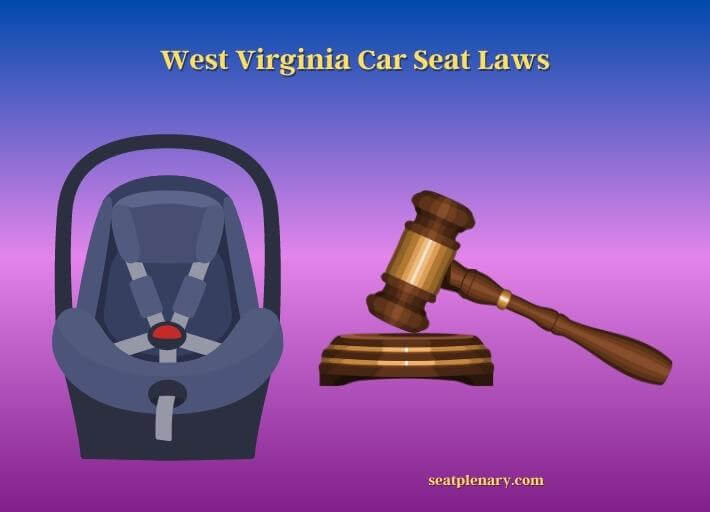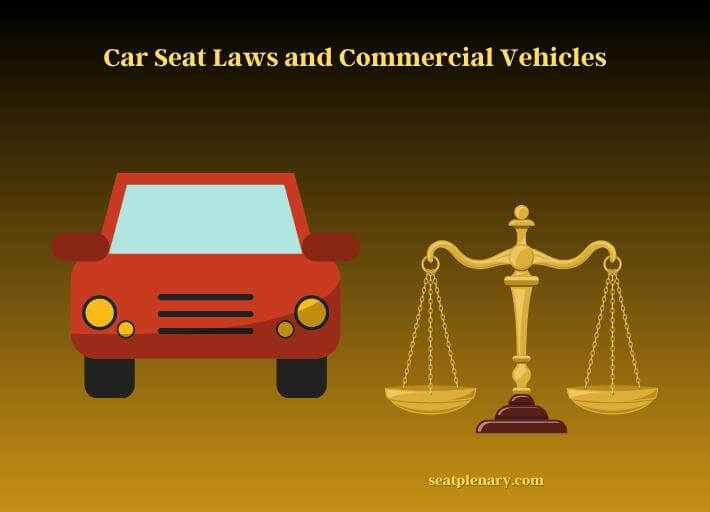Ensuring your child’s safety while driving is not just a personal priority but also a legal obligation. Car seat laws exist to safeguard young passengers from potential harm during vehicular accidents.

This article dives into the specifics of the car seat laws in West Virginia. Each state has its regulations, and understanding them helps you protect your child and avoid penalties.
Child Passenger Safety: Importance & National Statistics
The leading cause of death for children in the US is motor vehicle crashes. Proper use of car seats significantly reduces the risk of fatality and severe injury in case of an accident.
According to the National Highway Traffic Safety Administration (NHTSA), the use of car seats reduces the risk of infant death by 71%, and for toddlers, the risk is reduced by 54%.
Car Seat Laws in West Virginia
Car seat laws in West Virginia are governed by the provisions in Chapter 17C, Article 15, Section 48 of the West Virginia Code. The primary goal of these laws is to ensure the safety of young passengers while traveling. Violating these laws can result in penalties, including fines and points on your driving record. More importantly, compliance with these laws significantly increases the safety of children in the event of a car accident.
The Basics: State Law Requirements
Under West Virginia law, all children under the age of 8 years or shorter than 4 feet 9 inches must be secured in a child safety seat or a booster seat. The specific type of seat depends on the child’s age, height, and weight.
Rear-facing car seats are required for children under two years of age or until they reach the maximum weight or height limit specified by the car seat manufacturer.
Children aged two until at least four years, or until they outgrow the limits of the rear-facing seat, must be placed in a forward-facing car seat equipped with a harness.
Children aged four until at least eight years or those who have outgrown the forward-facing seat’s height or weight limit must use a belt-positioning booster seat until the vehicle’s seat belt fits them correctly.
For children above the age of 8 or taller than 4 feet 9 inches, a regular seat belt can be used if it fits them correctly.
Detailed Explanation of West Virginia’s Laws
West Virginia’s car seat laws have been formulated with a comprehensive approach, considering different aspects of child safety. The stipulations based on age, height, and weight ensure that the child’s safety measures grow with them.
The rear-facing car seats requirement for children under two years aligns with recommendations from the American Academy of Pediatrics (AAP). The AAP states that rear-facing car seats provide the best support for a child’s head, neck, and spine in the event of an accident.
When children outgrow the limits for rear-facing seats, the law stipulates a shift to forward-facing seats with a harness. This type of seat provides a higher level of protection than a seat belt alone.
When children outgrow their forward-facing seats, they must transition to a booster seat. Booster seats lift the child so that the seat belt fits correctly over the strongest parts of their body.
It’s also important to note that West Virginia law specifies that all car seats and booster seats must be used according to the manufacturer’s instructions. This means parents and caregivers should always check the car seat manual to ensure they’re using the seat correctly, including proper attachment to the vehicle and correct harnessing of the child.
Remember that the child’s safety is paramount. Even if your child is eager to switch to the “big kid” seat, it’s crucial to ensure they have reached the necessary height and weight limits before making the transition.
The Evolution of West Virginia Car Seat Laws
Understanding the evolution of West Virginia’s car seat laws provides context and emphasizes the increasing focus on child safety on the road over time.
Historical Perspective
West Virginia first established car seat laws in the 1980s, following a nationwide trend of recognizing the need for specialized safety measures for children in vehicles. These early laws were basic, requiring only that children be placed in some type of child safety seat. There were no specific requirements regarding the type of seat or the age or size of the child, leaving much room for interpretation.

Over time, as research has shown the effectiveness of car seats in preventing serious injuries to children in car accidents, the laws in West Virginia have become more precise and detailed. This evolution mirrors a growing understanding of the specific needs and vulnerabilities of children of different ages and sizes.
Recent Updates and Amendments
In recent years, the laws have been updated to reflect the latest recommendations from child safety experts, including those from the American Academy of Pediatrics (AAP). One of the most significant changes was the mandate for children under two years to use rear-facing car seats, which are considered the safest option for this age group.
This change was made in response to studies showing that children in rear-facing seats are less likely to be seriously injured in a car accident than those in forward-facing seats. The law now requires children to remain in these rear-facing seats until they are at least two years old or until they exceed the height or weight limit specified by the car seat manufacturer.
Another significant update was the requirement for older children to use booster seats. Children aged four until at least eight years or who have outgrown the height or weight limit of their forward-facing seat must use a belt-positioning booster seat until the vehicle’s seat belt fits them correctly. This change aims to ensure that seat belts, designed for adults, can effectively protect children who are not yet big enough to wear them properly.
Furthermore, the penalty for non-compliance has also been revised. Currently, failing to adhere to the car seat laws in West Virginia can result in a fine and points added to your driving record, emphasizing the importance of following these laws not only for your child’s safety but also to avoid legal consequences.
In conclusion, the evolution of West Virginia’s car seat laws shows the state’s commitment to keeping up with the latest research and recommendations on child safety in vehicles. It’s crucial for parents and caregivers to stay updated on these laws to ensure they’re taking all necessary precautions to protect their children on the road.
Age-Related Car Seat Requirements
Newborns and Infants: Rear-Facing Seats
All infants and toddlers should ride in a rear-facing seat until they are at least two years old or reach the highest weight or height allowed by their car seat manufacturer.
Toddlers: Forward-Facing Seats
After outgrowing the rear-facing car seat, children should be placed in a forward-facing car seat with a harness for as long as possible, ideally until they reach the weight and height limits set by the seat’s manufacturer.
Children Aged 4-8: Booster Seats
Kids who have outgrown the forward-facing limit should use a belt-positioning booster seat until the vehicle seat belt fits properly.
Children Above 8: Seat Belt Rules
Seat belts can be used when they fit correctly, typically when the child is 4 feet 9 inches tall. The lap belt must lay across the upper thighs, not the stomach, and the shoulder belt should fit across the shoulder and chest, not the neck or face.
Weight and Height Considerations
When it comes to ensuring safety in a car, simply using a car seat isn’t enough. The type of car seat and its configuration need to be adjusted based on a child’s weight and height. In this section, we’ll explore how these considerations impact the choice of car seat.
Understanding Height and Weight Limits for Each Car Seat Type
Every car seat type – whether it’s a rear-facing seat, forward-facing seat, or booster seat – comes with specific height and weight restrictions. These restrictions are based on safety tests and are designed to ensure that the car seat can provide maximum protection to your child.
For instance, rear-facing car seats in West Virginia are required for children under two years or until they reach the seat’s maximum weight or height limit. These limits vary among different car seat models, so it’s important to refer to the manufacturer’s guidelines.
Similarly, forward-facing car seats are typically designed for children who are at least two years old and have outgrown the rear-facing seat’s limits, until they reach the forward-facing seat’s maximum height or weight capacity.
Booster seats, on the other hand, are designed for older children who have outgrown their forward-facing seats but are not yet tall enough for the vehicle’s seat belt to fit them properly. Again, the exact weight and height requirements can differ among models.
Impact of Child’s Growth on Car Seat Transition
As children grow, their safety requirements change. Their height and weight play a significant role in determining when it’s time to transition to the next type of car seat.
For example, when a child exceeds the maximum weight or height limit for a rear-facing seat, they should transition to a forward-facing seat with a harness. Once they outgrow the forward-facing seat, it’s time to move to a booster seat.
Eventually, when the child is tall enough (usually around 4 feet 9 inches), the vehicle’s seat belt should fit them correctly, and they can transition from a booster seat to the vehicle’s seat belt.
It’s essential to keep track of your child’s growth and adjust the car seat as needed. Always follow the manufacturer’s guidelines regarding height and weight limits, and remember: it’s safer to delay transitions as long as possible within the limits of the car seat. The goal is to maximize the protection each seat offers at every stage of your child’s growth.
Proper Installation of Car Seats
Proper installation is crucial for a car seat to serve its purpose. Make sure to read the manufacturer’s installation guide carefully and check that the seat is tightly secured — it should not move side-to-side or front-to-back more than one inch.
Common Mistakes and How to Avoid Them
Common installation mistakes include using the wrong belt path, not securing the seat tightly enough, and turning the car seat forward-facing too early. Regularly inspecting your car seat setup can help prevent these mistakes.
Choosing the Right Car Seat for Your Child
When shopping for a car seat, consider factors such as your child’s age, height, and weight, as well as the seat’s safety features, ease of installation, and fit in your vehicle.
Do your research and read product reviews before purchasing. Consumer Reports and the NHTSA offer reliable reviews and safety ratings for various car seat models.
Car Seat Laws and Commercial Vehicles
In West Virginia, taxis are exempt from car seat laws, but rideshare services are not. When using rideshare services, passengers must provide appropriate car seats for their children.

Many taxi companies and rideshare drivers in West Virginia carry car seats to accommodate passengers with young children. However, it’s always best to inquire in advance or bring your own.
Penalties for Violation of Car Seat Laws
Violating West Virginia’s car seat laws can result in fines and points on your driving record. More importantly, it puts your child’s life at risk.
Repeated offenses can negatively impact your driving record, potentially leading to increased insurance premiums.
Car Seat Inspection and Assistance
Several organizations in West Virginia offer free car seat inspections. You can find your nearest inspection station through the NHTSA’s online locator.
For families who cannot afford a car seat, there are local and national programs offering assistance. Check with the West Virginia Department of Health and Human Resources for available resources.
West Virginia Car Seat Safety Assistance Locations
- West Virginia Department of Health Seat Safety Inspections: Providing comprehensive safety seat checks, the department works tirelessly to ensure children are protected on the road.
- NHTSA Car Seat Inspection Center in West Virginia: As a branch of the national highway traffic safety association, this center specializes in car seat inspections, ensuring the safety standards are met.
- Fauquier County Child Seat Safety Check: Located in the heart of West Virginia, Fauquier County offers child seat inspections that aid parents in providing a safe travel environment.
- Hanover County Child Safety Seat Information: This center offers invaluable information about child car seat safety, alongside practical assistance with car seat installation.
- Herndon Police Department Child Safety Seat Inspection: Collaborating with certified technicians, Herndon PD delivers critical services such as car seat inspections and safety education.
- West Virginia Tech Police Department Seat Safety Checks: Partnered with local law enforcement, this institution offers seat safety checks, prioritizing child safety on and off-campus.
- Loudoun County Installation and Inspections: They offer comprehensive car seat inspection and installation services, helping parents secure their children correctly.
- Roanoke Fire-EMS Child Passenger Safety: This service combines the expertise of EMS and fire personnel to provide vital safety checks and education on child passenger safety.
- Arlington County Child Safety Seat Registration Form: This county enables registration for child safety seat inspections, ensuring a streamlined process for parents and caregivers.
- Fairfax’s Free Child Safety Seat Inspections: Offering cost-free child safety seat inspections, Fairfax is committed to keeping child passengers safe and secure.
Informative Videos on Car Seat Safety
Infant car seat installation
Installing a Car Seat Properly
Children Should Ride in the Back Seat
Rear-Facing Convertible with Seat Belt
Conclusion
West Virginia’s car seat laws aim to ensure the safety of child passengers. Adherence to these laws, including using the appropriate car seat for your child’s age, height, and weight, is both a legal obligation and a crucial step in protecting your child on the road.
Parents play a crucial role in child passenger safety. By understanding and following car seat laws, you can significantly reduce the risk of injury to your child while driving.
FAQs
What if I Can’t Afford a Car Seat in West Virginia?
If affording a car seat is challenging, seek assistance from local non-profits and state programs that provide car seats at no or low cost.
Are there Exemptions to the Car Seat Law in West Virginia?
Exemptions exist for certain commercial vehicles like taxis. However, personal vehicles and rideshare services must comply with the car seat laws.
How do I know if my Child’s Car Seat is Installed Correctly?
A correctly installed car seat should not move more than one inch in any direction. If you’re unsure, consider having your installation checked at a local inspection station or by a certified child passenger safety technician.
Is it Safe for my Child to Use a Second-Hand Car Seat?
While a used car seat might seem cost-effective, it’s essential to ensure it hasn’t been in an accident, is not past its expiration date (usually six years), and comes with its original instructions and parts.
Can my Child Sit in the Front Seat in West Virginia?
The AAP recommends that children under the age of 13 sit in the back seat. Front-seat airbags can be dangerous for young children, even if they’re using a car seat or booster seat. Always refer to your vehicle and car seat manufacturer’s guidelines for additional recommendations.
West Virginia’s car seat laws is crucial for the safety of your child. By adhering to these regulations and recommendations, parents and caregivers can help ensure a safer travel experience for the youngest passengers.
Read More:
